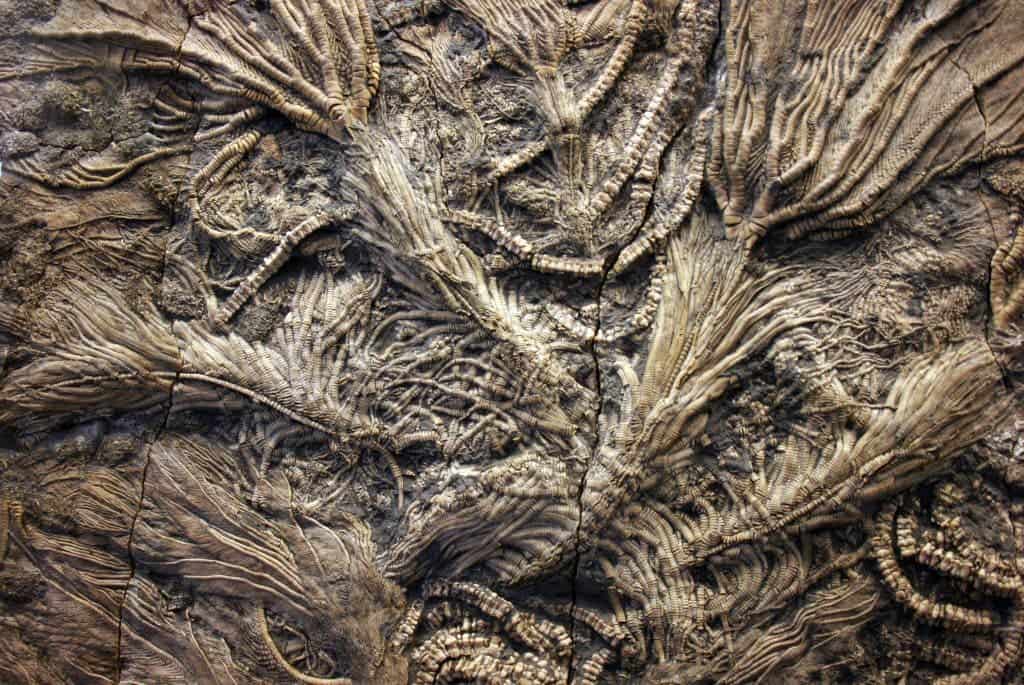When you think of fossils, things like dinosaurs or ancient trees probably pop to mind. But if you’re a true geology aficionado, you probably know that those are far from the most common fossils. Instead, things like ammonites or corals are the most common fossils; and of course, crinoids are a coveted find.
Crinoids are often referred to as “sea lilies” even though they’re technically animals, not plants. They have been around since the late Cambrian, some 500 million years ago — 250 million years before the dinosaurs. Some of them still exist today.
Crinoids are echinoderms, a group that also includes starfish, sea urchins, and sand dollars. What sets crinoids apart, however, is their distinct appearance and mode of life. They typically have a long, stalk-like structure called a column, which anchors them to the sea floor, and a crown made up of feathery arms that extend outwards to capture food. These arms are adept at filtering plankton and small particles from the water, which they then direct toward their mouth located at the center of the crown.

Crinoids usually have a stem used to attach themselves to a substrate, but many live attached only as juveniles and become free-swimming as adults. They are very fragile and require specific conditions to be preserved, so fossils like this one are very rare indeed.
Crinoid fossils are most commonly found in limestone deposits that were once ancient seabeds. These fossils often consist of the stalk or column, the most durable part of the crinoid’s anatomy. The column is made of disc-like segments, or ossicles, which can easily fossilize. When these ossicles are found individually, they resemble tiny, flat buttons or coins. Occasionally, entire crowns are preserved, providing a more complete picture of these ancient creatures.
The fossil record of crinoids is rich and diverse. Over 6,000 species of fossil crinoids have been described, each offering clues about the environments they inhabited. Some had short, stout stalks, anchoring them firmly to the seabed, while others had long, flexible stems, allowing them to sway and filter food from higher in the water column. The crown’s morphology also varied widely, with some species having long, slender arms, while others had short, robust ones.

These fossils are not just scientifically important; they are also aesthetically striking. Crinoid ossicles are often found embedded in rock, creating patterns that resemble tiny, intricate stars or flowers. In some regions, these fossilized fragments are so abundant that they have been used as decorative stones for centuries, particularly in the form of “star stones” or “Indian beads,” which were once used by Indigenous peoples in North America as beads in necklaces and other adornments.
Crinoids are still alive

The story of crinoids is not just one of ancient origins but also of survival and adaptation. Throughout Earth’s history, crinoids have faced numerous challenges, including mass extinctions that wiped out large portions of life on the planet. The most devastating of these was the Permian-Triassic extinction event, around 252 million years ago, which saw the disappearance of an estimated 95% of marine species. Crinoids were severely impacted, with only a few lineages surviving.
Despite this catastrophic loss, crinoids managed to rebound during the Mesozoic Era, the age of dinosaurs. However, they never regained their former dominance. Instead, they adapted to new environments, with many species evolving a more mobile, stalk-less form known as comatulids or feather stars. These modern crinoids are much more flexible and can move across the sea floor, giving them an advantage in the changing oceans of the time.

The resilience of crinoids is evident in their continued existence today. Although not as diverse or widespread as they once were, around 600 species of crinoids still inhabit modern oceans. They are often found in deep-sea environments, where they cling to rocks or coral reefs, extending their feathery arms into the water to feed. In shallower waters, feather stars are more common, with their colorful, delicate arms making them a popular subject for underwater photographers.
While crinoids might not be as famous as dinosaurs or trilobites, they are nonetheless some of the most exciting fossils around. For those interested in collecting crinoid fossils, they can be found in many regions around the world. The Midwest of the United States, particularly in states like Indiana, Illinois, and Missouri, is known for its rich deposits of crinoid fossils. European sites, especially in England and Germany, also yield well-preserved crinoid specimens, often in association with other marine fossils from the same time period.
However, be mindful — not all areas allow the harvesting of fossils. Always check if that is legal (and moral). If not, you can always admire crinoid fossils in museums or geological exhibitions.










